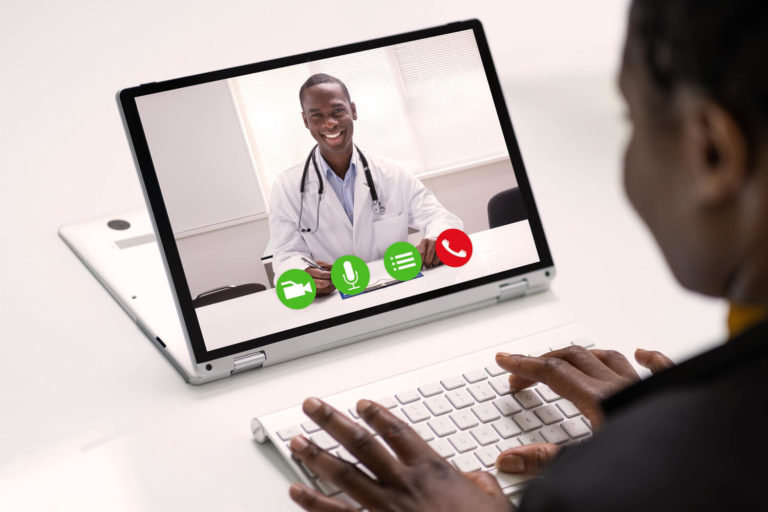Ever since telehealth enabled remote monitoring of patients, it’s been making life easier for both healthcare providers and patients as they learn to collaboratively manage chronic conditions. Remote patient monitoring empowers patients to engage in their care and strengthen relationships with their providers. Sharing biometrics like heart rate, blood pressure, cognitive function, blood glucose levels, and vitamin deficiencies used to require scheduling regular office visits — which can be stressful, increasing cancellations, decreasing compliance, and limiting patient-provider communication. Plus, in-person visits became almost impossible during the COVID-19 pandemic.
Nurturing relationships via smartphones and other digital devices can deepen ties with patients and improve outcomes by exchanging health data via RPM technologies. They allow a care team to decide in real-time when chronic conditions like congestive heart failure, diabetes, or dementia require intervention. So, it’s not surprising that the EP Lab Digest reports 88% of healthcare providers are either enjoying or evaluating remote patient monitoring devices for their teams.
How to level-up patient care via remote monitoring of patients
When they can regularly monitor high-risk patients’ health information from afar, healthcare professionals can practice more effective Care Management. This improves patient engagement and alleviates stress for both patients and healthcare providers. Here are 6 ways you can leverage remote monitoring of patients to elevate your team’s quality of care.
1. Improve responsiveness with remote patient monitoring of patients
When it comes to managing chronic conditions, time is of the essence. Remote and continuous monitoring of patients enables healthcare providers to track medication adherence, activity levels, and a patient’s vital signs — such as heart rate, blood pressure, oxygen levels, and glucose levels — in real-time. If their biometrics drop out of the appropriate range, clinicians can respond immediately with the appropriate patient care touchpoints. Encouraging patients to come in for an office visit before their conditions escalate can save them from more invasive treatments later.
Chronic diseases make up the majority of America’s healthcare budget. The CDC reports that 34 million Americans are living with diabetes and another 88 million are diagnosed with pre-diabetes. According to Million Hearts®, one-third of deaths in the U.S. are caused by heart disease, and The Asthma and Allergy Foundation of America estimates that the annual direct costs of asthma in the United States are $50.1 billion (mostly for hospital stays). Improving responsiveness can give patients more time to find the intervention that can save their lives.
2. Promote appropriate escalation with remote monitoring of patients
Anxious patients can sometimes become hyper-responsive. According to the CDC, 130 million Americans visited the ER last year — yet only 9% of ER visits resulted in hospitalization. By escalating too soon, patients can run up costly bills that jeopardize their quality of life. Telehealth and patient monitoring devices can help keep chronic disease Care Management out of the ER and keep stress levels to a minimum.
Mobile devices make communication much easier than scheduling and performing office visit exams. Supporting Care Management strategies with remote patient monitoring enables your team to make care delivery more immediate, more efficient, and less exhausting. It also allows them to quell the fears of patients or their caregivers who may otherwise schedule an unnecessary appointment.
3. Improve care plan compliance with remote monitoring of patients
Medication is a necessary part of many treatment regimens, but it can be difficult for healthcare professionals to know with certainty that patients are complying with their prescriptions. A remote health monitoring system gives patients reminders to take their medications and can alert care teams if those instructions have not been followed.
Patch-based sensors are RPM devices that continuously gather biometric data — from electrocardiogram and heart rate to body posture and activity levels — and stream data to a patient’s smartphone and a clinical platform. When patients are able to collect their own data from wearables and other remote patient monitoring devices, they play a more active role in their care and participate in decision-making.
HIMSS found that when patients discuss self-generated health data with their providers, 60% feel more empowered to manage their condition. Decreasing the number of office visits enables clinicians to dedicate more time and attention to monitoring and educating their most at-risk patients with chronic diseases.
4. Provide back-end and tech support for your care team
Your care teams are your front line for ensuring quality patient outcomes. Many healthcare systems want to integrate telehealth, but don’t have the bandwidth necessary to fulfill all the back-end administrative functions associated with connected medical devices.
Many patients — and even clinicians — aren’t MedTech-savvy. And they shouldn’t need to be. Addressing technical challenges or equipment malfunctions will never be your job if your healthcare organization partners with a Care Management platform provider that includes telehealth technical support for patients and care teams. Finding the most technologically supportive platform provider will ensure that you always have someone readily available to address any issues before they lead to possibly faulty medical diagnoses.
Remote monitoring of patients requires sanitizing, changing, ordering, and shipping new equipment regularly. Choosing a highly experienced telehealth services partner will allow you to offload all these administrative tasks so that your clinical staff can get back to focusing on their primary clinical responsibility — providing quality care.
5. Reduce hospital readmissions with remote monitoring of patients
In 2020, readmissions cost U.S. hospitals $563 million, according to the Kaiser Family Foundation. Early adopters of remote patient monitoring devices were hospitals and home health organizations that prioritized reducing readmissions. Their clinical research has yielded some pretty impressive efficacy data.
A study conducted by Preventice found a smartwatch could reduce a significant percentage of unnecessary ER visits and outpatient visits. Remote patient monitoring helped reduce hospital readmissions by 65% among congestive heart failure patients in a Christus Health clinical trial. In a year-long study published in mHealthIntelligence, researchers observed a 30% reduction in hospitalizations after implementing remote patient monitoring. Telemedicine and remote patient monitoring programs have helped reduce workloads, decreasing COVID-19 transmission risk by reducing ER and ICU traffic.
6. Relieve stress with remote patient monitoring
When patients don’t hear from their healthcare provider regularly, don’t know whether they’re using remote devices properly, or don’t understand the data being shared, they can become anxious. Stress exacerbates most chronic and acute conditions. It’s difficult to achieve optimal health outcomes when patients and clinicians are forced to take extra steps and perform extraneous administrative tasks.
Effective telehealth and remote patient monitoring can streamline or bypass certain administrative and service tasks, giving clinical staff more time to analyze and discuss the patient-generated data and the valuable insights it offers with each patient. The more that is discussed, the more motivated patients become to continue diligently monitoring themselves.
Whether it’s oxygen levels, heart rate, or COPD symptoms, RPM services enable customized, secure Care Management via smartphones and wearable medical devices. When clinical staff can reduce the stress caused by overbooked appointments, they can assist more patients per day, enjoying higher job satisfaction.
Top devices for remote monitoring of patients
Patient monitoring technologies enable clinicians to consistently collect biometric data and see what a patient is or isn’t doing, then provide more education on the patient’s condition digitally. When they can observe and track vital signs to monitor chronic conditions like hypertension, heart failure, diabetes, COPD, asthma, dementia, and mental health disorders, healthcare providers can continue remote monitoring of patients as long as needed, building trust and nurturing relationships.
RPM devices securely transmit patient data to a third-party, HIPAA-compliant RPM platform that analyzes and delivers it to clinicians via user-friendly dashboards, enabling them to detect concerning trends in real-time and intervene long before escalation begins.
Here are some of the most commonly used FDA-approved remote patient monitoring devices.
Smart scales for monitoring of patients’ weight
A daily weight gain of 3 or more pounds can indicate cardiovascular issues, such as congestive heart failure. At-risk patients experience shortness of breath, tightness in the chest, and dizziness. While it is completely normal for weight to fluctuate, weight gain in at-risk patients can be a precursor to more serious conditions. By monitoring a patient’s body weight, clinicians can quickly identify signs of heart failure and focus on early management.
Obesity — which the CDC reports affects nearly 40% of American adults — can lead to heart disease, stroke, Type 2 diabetes, and certain forms of cancer. Regular weigh-ins are critical for this patient population, and smart scales make that task both easier and more efficient. Losing weight too quickly can be a symptom of multiple conditions, so reporting weight data to practitioners may help with critical diagnoses.
Glucometers for monitoring of patients’ blood sugar
Diabetes is the 7th leading cause of death in the U.S. as well as the 4th most common cause of physician visits, according to the Springer Journal. If poorly managed, diabetes can cause kidney failure, heart attack, stroke, and blindness. By utilizing a blood glucose meter to remotely monitor blood sugar levels, clinicians can better assess whether a patient’s management plan is working and make adjustments to optimize care.
Continuous glucose monitoring (CGM) devices track blood sugar levels 24/7 and send reports every few minutes through a tiny subcutaneous sensor inserted into the arm or abdomen. These devices detect interstitial glucose levels and provide valuable information at important points during the day: before, during, and after exercise; prior to driving; before and after taking an exam; and in the middle of the night.
Blood pressure cuffs for monitoring of patients’ heart health
Hypertension is a major risk factor for many chronic diseases like heart failure, atrial fibrillation, and stroke. Enabling patients with hypertension to ensure that their blood pressure stays within a healthy range between office visits is critical. Blood pressure cuffs allow clinicians to detect complications early and provide prompt treatment or intervention.
A blood pressure monitor displays systolic blood pressure, diastolic blood pressure, and heart rate. The top number is the systolic blood pressure measurement — the amount of pressure in the arteries when the patient’s heart is beating. According to the American Heart Association, any reading above 130 mmHg is considered hypertensive.
Pulse oximeters for monitoring of patients’ oxygen levels
Patients with conditions that affect blood oxygen levels like heart attack, heart failure, COPD, anemia, lung cancer, asthma, and pneumonia may benefit from a remote pulse oximeter, which measures heart rate and oxygen saturation in a patient’s red blood cells.
This clip-like probe is placed on a finger or earlobe and uses light to measure how much oxygen is in the blood. This information helps healthcare providers decide whether a patient needs extra oxygen based on their blood oxygen saturation level (SpO2) and pulse rate. Patients should seek medical attention if their reading indicates a low pulse rate, a high pulse rate, or an SpO2 under 90% (hypoxia).
Remote spirometers for monitoring of patients’ lungs
According to American Family Physician, chronic obstructive pulmonary disease (COPD) is the most common respiratory disease and the 4th leading cause of death in the U.S. A spirometer measures lung volume for patients with COPD, asthma, or pulmonary fibrosis. Shortness of breath, frequent coughing, or wheezing can all indicate a risk of lung disease and probably indicate the need for remote spirometry. Frequent lung capacity measurements help healthcare providers determine whether this chronic disease is improving or worsening as quickly as possible.
Patients just take a deep breath and blow into the mouthpiece as hard and quickly as they can. The spirometer measures forced vital capacity (the amount of air exhaled) and forced expiratory volume (the amount of air exhaled in the first second). Once healthcare providers detect an obstructive or restrictive ventilatory pattern, its severity is graded and care plan steps are determined.
Activity trackers for the monitoring of patients’ movement
After a neurological injury like stroke, traumatic brain injury, or spinal cord injury, patients may experience paralysis and lose motor control. Regular movement will promote neuroplasticity — the rewiring of the central nervous system to recover damaged functions. The more a patient moves, the better the brain gets at recognizing the demand for that movement and the better it adapts.
Unfortunately, many patients lack the motivation to consistently perform the same movement over and over. Activity trackers provide visual progress reports that boost daily motivation. Remote activity monitoring helps physical or occupational therapists track their clients’ movements outside of the clinic and understand exercise effectiveness. It also helps neurologists, cardiologists, oncologists, endocrinologists, and geriatrics specialists track and inspire activity for patients with a wide range of chronic conditions that can be improved with the proper amount of movement.
Start leveraging remote monitoring of patients to improve your outcomes
An effective and consistent remote patient monitoring system expands the efficacy of Care Management — a critical care plan compliance tool — and nurtures patient-provider relationships. The more clinicians can trust patients to understand their own chronic conditions and treatments, the less stress they’ll experience.
Remote monitoring promotes patient engagement and satisfaction, which can lead to better health outcomes. And better patient outcomes make for more fulfilled healthcare providers. If you’d like to inspire more of each, read our Definitive Guide to Remote Patient Monitoring.


